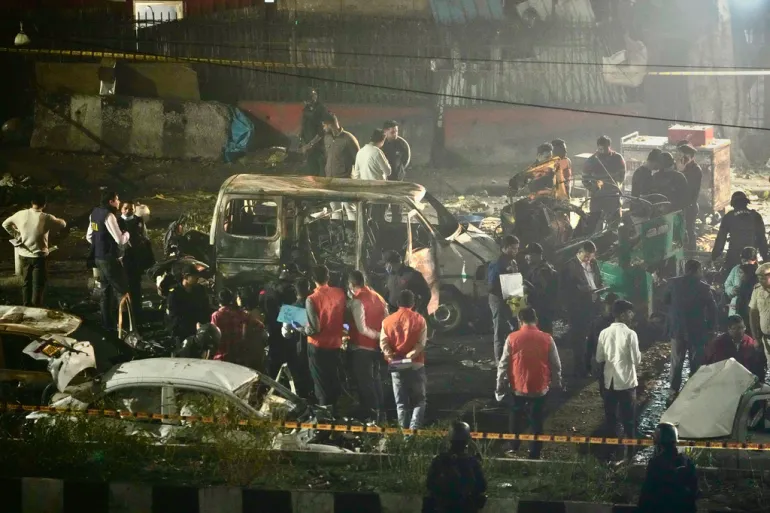
-
ceo.bfi@gmail.com
Send Email
-
2C, C-6/A Block, Janakpuri, Delhi India 110058
Visit Our Office
99902-92279
Confidentiality Guaranteed
99902-92279
Confidentiality Guaranteed

Nov
Delhi Red Fort Bomb Blast

“Delhi Red Fort Bomb Blast: How Forensic Science is Uncovering the Truth Behind the Explosion”
On 10 November 2025, a high-intensity explosion ripped through a slow-moving white Hyundai i20 near the Gate 1 / Metro Station area of Delhi’s historic Red Fort. Initial confusion about a CNG cylinder blast gave way to a full-scale terror investigation. The blast casualty count rose, and investigators soon discovered that the vehicle had changed hands several times and had unusual ownership records.
In incidents like this, forensic science becomes the backbone of investigation—providing scientific evidence to answer critical questions: What exactly exploded? How was it triggered? Who was behind it?
The Scene & Key Unanswered Questions

Why was there no crater, no visible wiring, and no embedded nails or shrapnel typical of conventional bombs?
How was such a powerful blast triggered in a vehicle that was momentarily halted at a traffic signal or red light?
What was the ownership history of the Hyundai i20 — the multiple registrations and transfers raised serious red flags about its use?
What is the scale and nature of explosives involved? On-site forensic teams collected more than 40 samples, including cartridges and multiple explosive types. Preliminary analysis suggests one sample is ammonium nitrate; another is believed to be more powerful.
These uncertainties underscore the essential role of forensic science to decode what really happened.
How Forensic Science Will Drive the Investigation
Here’s a breakdown of how forensic disciplines come together in this kind of blast investigation:
Crime-Scene Documentation & Evidence Preservation

From the moment investigators arrive:
Forensic photography and videography document the blast area, vehicle position, debris field and surrounding damage before contamination occurs.
Evidence—including the vehicle’s remains, fragments of metal, soil samples, and residues—must be collected carefully and logged to maintain the chain of custody.
Given a crowded and historic zone (Old Delhi) with many bystanders, securing the scene for uncontaminated sampling is especially critical.
Explosive Residue & Chemical Analysis
Because of the unusual evidence (e.g., lack of crater, wiring, shrapnel) investigators are considering non-traditional explosive or fuel-based ignition mechanisms.
Forensic chemistry comes into play:
Samples collected (more than 40 in this case) include cartridges and two different types of explosive materials.
Preliminary results suggest one sample is ammonium nitrate; the second may be more powerful than ammonium nitrate.
Techniques such as Gas Chromatography–Mass Spectrometry (GC-MS), Fourier-Transform InfraRed (FTIR) spectroscopy, X-Ray Diffraction (XRD) may be used to identify and quantify explosive compounds.
Finding the specific composition helps link the device to manufacturing or supply chain—vital in tracking terror modules.
Vehicle Forensics & Blast Reconstruction

Because the device was placed in a vehicle,the forensic team will analyze:
Ownership history of the car: multiple transfers, possible misuse of registrations, deliberate attempts to mask true ownership.
Modifications to the vehicle: hidden compartments, alterations in fuel tanks, wiring, timers or remote triggers.
Damage pattern: The position of the vehicle at time of detonation (at red light/stop), direction of blast, scorch patterns, fragment spread. From this, forensic engineers reconstruct the explosion dynamics: Was the car moving when the device detonated? Was the device in trunk/back seat/engine bay?
Metallurgical analysis of vehicle parts helps determine how the blast initiated and propagated.
Fingerprint & DNA Profiling

Even in high-heat blasts, biological and fingerprint evidence may survive:
Latent fingerprints on detonator parts, vehicle remains, interior surfaces may link individuals to the device.
DNA profiling from biological remains (occupants of vehicle, victims) supports identification, especially when visual recognition is impossible due to blast fragmentation.
In this incident, three occupants died in the car — forensic DNA becomes crucial to confirm identities and links.
Digital Forensics & Communication Tracking

Modern explosive attacks are seldom isolated from digital footprints:
CCTV footage, vehicle telematics/GPS, mobile phones in or around the vehicle, SIM data all give clues. For instance, the car was parked for hours before the blast—CCTV and digital tracking can capture that timeline.
Extraction of deleted messages, calls, emails, cloud data may reveal planning, remote control or timer activation.
Linking digital evidence with physical forensic evidence enables building the “who, when, how” chain.
Forensic Intelligence Integration
Collecting data is not enough — integrating findings across disciplines and linking to broader terror networks is where crucial value lies.
The forensic chemical analysis indicating ammonium nitrate or higher explosive leads to tracing of supply routes—linking to seizures in nearby regions (e.g., Faridabad) and known terror modules.
Vehicle ownership anomalies and digital evidence may link the case to foreign or domestic terror names (for example, the Pakistan-based Jaish‑e‑Mohammed mentioned in relation to the case).
Forensic intelligence helps law-enforcement not only solve the incident but disrupt the network and prevent future attacks.
Challenges Faced in This Investigative Scenario
The absence of typical bomb markers (wires, crater, nails) complicates classification of the device as a conventional bomb vs a fuel-explosion scenario.
Intense heat may vaporize or degrade explosive residues, making chemical analysis more difficult.
The location—old city, heavy traffic, dense public presence—means high risk of contamination or removal of evidence by bystanders.
Media and public pressure demand quick answers, but forensic processes must remain methodical and accurate.
Why Forensic Science Is Indispensable
Forensic science delivers:
Credible scientific evidence that holds up in courts and supports prosecution.
Reconstruction of sequence and mechanism, turning devastation into data.
Linkages between device, perpetrators, and networks enabling disruption of future threats.
And in high-profile incidents like this one, it anchors law enforcement’s narrative in objective science rather than speculation.
Conclusion & Call to Action
The Delhi Red Fort car explosion is a stark reminder of evolving terror threats—where everyday vehicles can become engineered weapons. In such complex investigations, forensic science is the best weapon in the arsenal of justice.
At Brilliant Forensic Investigation (BFI), our expert team in Ujjain and Central India provides comprehensive forensic services: explosive residue analysis, vehicle forensics, digital forensics, DNA profiling, forensic photography & videography, and court-ready reporting.

If you face complex incidents requiring reliable forensic expertise—whether blast investigation, fraud detection or cyber-crime support—contact BFI today for a confidential consultation.
📞 Contact Us: 9990292279
🌐 Visit Our Website: https://forensicexpertinvestigation.com/
✉️ Email: ceo.bfi@gmail.com
Share Page
-
Tags
- Bomb Blast Forensic Analysis Delhi Blast Investigation Delhi Red Fort Bomb Blast Delhi Terror Attack 2025 Digital Forensics in Terror Cases DNA Forensic Profiling Explosive Residue Testing Forensic Science Investigation GC-MS Explosive Analysis Old Delhi Terror Attack 2025 Red Fort Car Explosion Vehicle Forensics India




